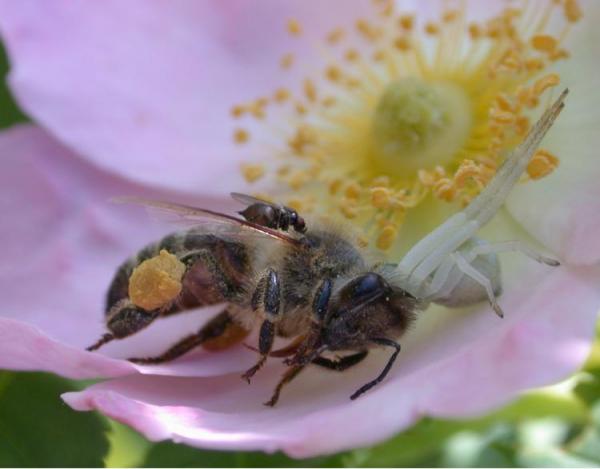Thread subject: Diptera.info :: What?s this fly doing?
Posted by amaira on 16-08-2007 09:26
#1
Yes, what is this little fly (tachinidae?) doing, on this bee trapped by a spider?

Posted by Paul Beuk on 16-08-2007 09:30
#2
Looking for some food. It is a specimen of
Desmopetopa (Milichiidae) and they have an uncanny sense of smell to locate dead honeybees on which they can be found feeding. As a rule these bees are captured by predatory insects (Asilidae, Reduviidae, etc.) or spiders (either in webs or, like this one, by crab spiders).
Posted by amaira on 18-08-2007 19:12
#4
Fantastic!!! Very fascinating. Thanks a lot for the information!
Posted by amaira on 18-09-2014 10:13
#5
Hallo everyone! A new question on same topic.
These are the Milichiidae in Sweden:
Sprickflugor Milichiidae
Leptometopa latipes (Meigen, 1830)
Madiza glabra Fallén, 1820
Milichia ludens (Wahlberg, 1847)
Neophyllomyza acyglossa (Villeneuve, 1920)
Phyllomyza securicornis Fallén, 1823
Desmopetopa I can´t find. Of what specimen is my fly?
Posted by amaira on 18-09-2014 10:13
#6
I try again with the photo.
Edited by amaira on 18-09-2014 10:25
Posted by skrylten on 18-09-2014 11:26
#7
Have a look at "Dyntaxa"
http://www.slu.se...xa/search/
The following Desmopetopa have been found in Sweden:
Desmopetopa varipalpis
Desmopetopa m-nigrum
Desmopetopa discipalpis
/Leif K
Posted by amaira on 18-09-2014 13:27
#8
Thanks Leif! But I got no match with Desmopetopa. But I found Desmometopa...??
Närmast underliggande taxa
Art: Desmometopa varipalpis
Art: Desmometopa m-nigrum
Art: Desmometopa palpalia
Art: Desmometopa discipalpis
Posted by Paul Beuk on 18-09-2014 13:34
#9
The image does not really allow ID of the specimen. Being on the spider prey and the black colour make it practically 100% certain that it is Milichiidae, but genus is impossible. Other genera than just
Desmometopa can be found on spider preys:
http://www.dipter...oad_id=183.
Posted by amaira on 20-09-2014 08:39
#10
Thankyou! I got my answer. it is Desmo-M-etopa, not Desmo-P-etopa :)

